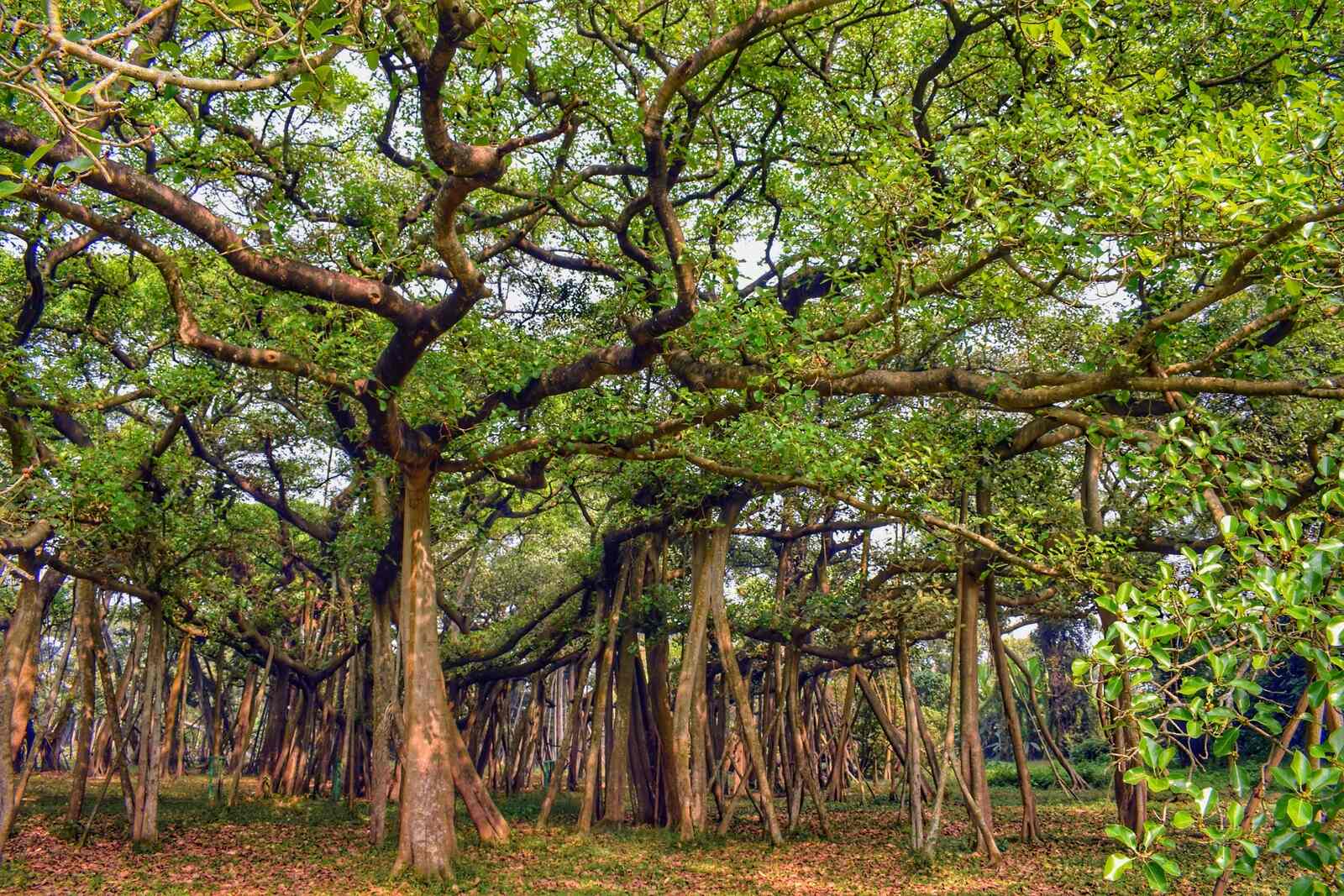
Did you know the Great Banyan Tree in India is over 250 years old? This incredible tree, located in the Acharya Jagadish Chandra Bose Indian Botanic Garden, is famous for its sprawling canopy that covers nearly 3.5 acres. It's not just one tree but a network of thousands of aerial roots that create the illusion of a forest. The Great Banyan Tree has survived numerous cyclones, diseases, and even the removal of its main trunk in 1925. Despite these challenges, it continues to thrive, making it a symbol of resilience and natural wonder. Join us as we explore 40 fascinating facts about this botanical marvel, from its historical significance to its unique biological features.
Key Takeaways:
- The Great Banyan Tree is a 250-year-old natural marvel, covering an area of 14,500 square meters and providing shelter to various species, but faces threats from urbanization and climate change.
- Conservation efforts and public awareness are crucial for protecting the Great Banyan Tree, as it continues to symbolize nature's resilience and the importance of preserving natural wonders.
The Great Banyan Tree: A Natural Marvel
The Great Banyan Tree, located in the Acharya Jagadish Chandra Bose Indian Botanic Garden in Howrah, India, is a wonder of nature. This tree is not only famous for its size but also for its unique characteristics.
-
The Great Banyan Tree is over 250 years old, making it one of the oldest living trees in the world.
-
It covers an area of about 14,500 square meters, which is roughly the size of a small forest.
-
The tree has more than 3,600 aerial roots that have descended from its branches and taken root in the soil.
-
The circumference of the tree's canopy is about 486 meters, making it the widest tree in the world.
Historical Significance
The Great Banyan Tree has a rich history that adds to its allure. It has witnessed centuries of change and has been a silent observer of history.
-
The tree survived two major cyclones in 1864 and 1867, which caused significant damage but did not kill it.
-
In 1925, the main trunk of the tree had to be removed due to a fungal attack, yet the tree continues to thrive.
-
The tree has been a part of many local legends and folklore, often considered sacred by the local population.
-
It has been a subject of study for botanists and scientists from around the world.
Ecological Importance
The Great Banyan Tree is not just a single tree but an entire ecosystem supporting various forms of life.
-
It provides shelter to numerous bird species, insects, and small mammals.
-
The tree's extensive root system helps in preventing soil erosion in the area.
-
It plays a crucial role in maintaining the local climate by providing shade and reducing temperatures.
-
The tree's leaves and fruits are a source of food for many animals.
Cultural Impact
The Great Banyan Tree holds a special place in the hearts of the people and has influenced various aspects of culture and art.
-
It has been featured in numerous poems, songs, and stories in Indian literature.
-
The tree is a popular tourist attraction, drawing visitors from all over the world.
-
It has been the site of many cultural and religious ceremonies over the years.
-
The tree is often used as a symbol of resilience and longevity in various forms of art.
Scientific Studies
Scientists have been fascinated by the Great Banyan Tree and have conducted numerous studies to understand its unique characteristics.
-
Researchers have studied the tree's root system to understand how it supports such a massive structure.
-
The tree's ability to survive without its main trunk has been a subject of interest for botanists.
-
Studies have been conducted to understand the tree's impact on the local ecosystem.
-
The tree has been used in various genetic studies to understand the growth patterns of banyan trees.
Visitor Experience
Visiting the Great Banyan Tree is a unique experience that leaves a lasting impression on everyone who sees it.
-
The tree is located in a well-maintained botanical garden, making it easily accessible to visitors.
-
There are walking paths around the tree, allowing visitors to explore its vast canopy.
-
Informational plaques provide details about the tree's history and significance.
-
The tree is a popular spot for photography, with its sprawling branches creating a picturesque setting.
Conservation Efforts
Efforts have been made to ensure the Great Banyan Tree continues to thrive for future generations to enjoy.
-
The tree is regularly monitored for any signs of disease or damage.
-
Conservationists have implemented measures to protect the tree from environmental threats.
-
Educational programs have been established to raise awareness about the importance of preserving such natural wonders.
-
The tree is part of a larger conservation effort to protect the biodiversity of the region.
Fun Facts
Here are some interesting tidbits about the Great Banyan Tree that you might not know.
-
The tree is often mistaken for a forest due to its size and the number of aerial roots.
-
It has been featured in several documentaries and TV shows about natural wonders.
-
The tree's canopy is so large that it can be seen from space.
-
It is one of the most photographed trees in the world.
Challenges and Threats
Despite its grandeur, the Great Banyan Tree faces several challenges that threaten its existence.
-
Urbanization and pollution pose significant threats to the tree's health.
-
Climate change has led to unpredictable weather patterns that can damage the tree.
-
Human activities, such as vandalism and littering, have also impacted the tree.
-
Efforts are ongoing to mitigate these threats and ensure the tree's survival.
Future Prospects
Looking ahead, the future of the Great Banyan Tree depends on continued conservation efforts and public awareness.
-
Scientists are exploring new methods to protect the tree from diseases and environmental threats.
-
Community involvement is crucial in preserving the tree for future generations.
-
Technological advancements are being used to monitor the tree's health more effectively.
-
The Great Banyan Tree remains a symbol of nature's resilience and the importance of conservation.
The Great Banyan Tree's Legacy
The Great Banyan Tree stands as a testament to nature's resilience and grandeur. Spanning over 3.5 acres, this colossal tree in Kolkata's Acharya Jagadish Chandra Bose Indian Botanic Garden is more than just a botanical wonder. It's a living piece of history, having survived lightning strikes, cyclones, and even the loss of its main trunk. With over 3,000 aerial roots, it creates a forest-like appearance, offering shelter to countless species of birds, insects, and small mammals. Visitors from around the globe come to marvel at its sheer size and beauty. This tree isn't just a natural marvel; it's a symbol of endurance and the intricate balance of ecosystems. Next time you're in Kolkata, make sure to visit this awe-inspiring giant. It’s a reminder of how incredible our natural world truly is.
Frequently Asked Questions
Was this page helpful?
Our commitment to delivering trustworthy and engaging content is at the heart of what we do. Each fact on our site is contributed by real users like you, bringing a wealth of diverse insights and information. To ensure the highest standards of accuracy and reliability, our dedicated editors meticulously review each submission. This process guarantees that the facts we share are not only fascinating but also credible. Trust in our commitment to quality and authenticity as you explore and learn with us.


